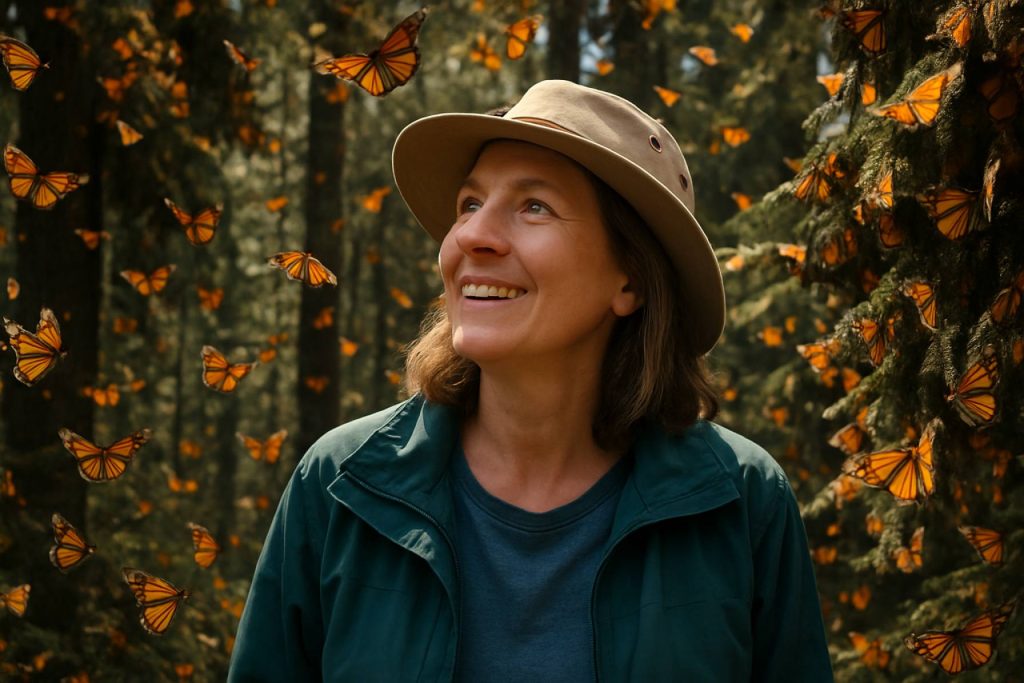
Inside the Angangueo Monarch Butterfly Biosphere Reserve: Where Millions of Monarchs Transform the Mexican Forests. Discover the Science, Spectacle, and Urgent Conservation Efforts Behind This Natural Wonder.
- Introduction: The Global Significance of Angangueo
- Geography and Climate of the Reserve
- Monarch Migration: Patterns and Mysteries
- Ecological Role of Monarch Butterflies
- Flora and Fauna: Biodiversity Beyond Butterflies
- Cultural and Historical Importance to Local Communities
- Threats: Climate Change, Deforestation, and Human Impact
- Conservation Strategies and Success Stories
- Scientific Research and Monitoring Initiatives
- Future Outlook: Challenges and Opportunities for Preservation
- Sources & References
Introduction: The Global Significance of Angangueo
The Angangueo Monarch Butterfly Biosphere Reserve is a UNESCO World Heritage Site located in the eastern part of the state of Michoacán, Mexico. This reserve is globally significant as one of the primary overwintering sites for the monarch butterfly (Danaus plexippus), a species renowned for its extraordinary annual migration spanning up to 4,500 kilometers from Canada and the United States to central Mexico. Each year, millions of monarchs converge in the oyamel fir forests surrounding the town of Angangueo, creating a natural spectacle that is both ecologically vital and culturally iconic.
The reserve covers approximately 56,000 hectares and is managed through a collaborative framework involving local communities, the Mexican government, and international conservation organizations. Its unique microclimate and forest composition provide the precise conditions monarch butterflies require to survive the winter months. The clustering behavior of the butterflies, which helps them conserve heat and energy, is only possible in the specific high-altitude forests found in this region.
The global importance of the Angangueo reserve extends beyond its role as a sanctuary for monarchs. It serves as a critical indicator of broader environmental health, reflecting the impacts of climate change, deforestation, and habitat fragmentation across North America. The monarch’s migratory phenomenon is recognized as an endangered biological process, and the reserve’s preservation is essential for maintaining this natural wonder. The site’s designation as a World Heritage property by UNESCO underscores its universal value and the need for international cooperation in its protection.
In addition to its ecological significance, the Angangueo Monarch Butterfly Biosphere Reserve is a focal point for scientific research, environmental education, and sustainable tourism. Organizations such as the World Wide Fund for Nature (WWF) and the Comisión Nacional de Áreas Naturales Protegidas (CONANP)—Mexico’s National Commission of Natural Protected Areas—play pivotal roles in monitoring butterfly populations, restoring habitats, and engaging local communities in conservation efforts. These initiatives not only help safeguard the monarchs but also support the livelihoods of people living in and around Angangueo.
Ultimately, the Angangueo Monarch Butterfly Biosphere Reserve stands as a symbol of transboundary conservation and the interconnectedness of ecosystems across continents. Its protection is vital for the survival of the monarch butterfly and for the preservation of a unique natural heritage that inspires awe and responsibility worldwide.
Geography and Climate of the Reserve
The Angangueo Monarch Butterfly Biosphere Reserve is situated in the eastern part of the state of Michoacán and the western part of the State of Mexico, in central Mexico. This reserve forms a critical component of the larger Monarch Butterfly Biosphere Reserve, which was designated a UNESCO World Heritage Site in 2008 due to its unique ecological significance and the extraordinary annual migration of monarch butterflies (UNESCO). The reserve covers an area of approximately 56,259 hectares, encompassing rugged mountainous terrain within the Trans-Mexican Volcanic Belt. Elevations in the reserve range from about 2,400 to over 3,600 meters above sea level, creating a diverse topography of steep slopes, deep ravines, and high plateaus.
The geography of the Angangueo Reserve is characterized by its dense forests, primarily composed of oyamel fir (Abies religiosa), pine, and mixed pine-oak woodlands. These forests provide the specific microclimatic conditions required by overwintering monarch butterflies. The region’s volcanic soils and high elevation contribute to the development of these unique forest ecosystems, which are not only vital for the butterflies but also support a variety of endemic flora and fauna.
The climate of the Angangueo Monarch Butterfly Biosphere Reserve is classified as temperate subhumid, with distinct wet and dry seasons. The wet season typically occurs from May to October, bringing the majority of the annual precipitation, which ranges from 700 to 1,250 millimeters. The dry season, from November to April, coincides with the arrival of millions of monarch butterflies from North America. During this period, temperatures are cool, often ranging from 0°C to 18°C, with occasional frosts at higher elevations. The cool, moist microclimate within the oyamel forests is essential for the survival of the butterflies, as it allows them to conserve energy and avoid desiccation during their winter dormancy (Comisión Nacional de Áreas Naturales Protegidas).
The reserve’s unique combination of altitude, forest cover, and climate creates a delicate balance that supports the monarch butterfly’s overwintering phenomenon. Conservation efforts in the region are coordinated by national and international organizations, including the Secretaría de Medio Ambiente y Recursos Naturales (SEMARNAT), which oversees environmental policy and protected areas in Mexico. The ongoing preservation of the Angangueo Reserve’s geography and climate is crucial for maintaining the annual monarch migration, one of the world’s most remarkable natural events.
Monarch Migration: Patterns and Mysteries
The Angangueo Monarch Butterfly Biosphere Reserve, located in the eastern part of the state of Michoacán, Mexico, is a critical sanctuary for the annual migration of the monarch butterfly (Danaus plexippus). Each autumn, millions of monarchs travel up to 4,500 kilometers from southern Canada and the United States to overwinter in the oyamel fir forests of central Mexico. The reserve, established in 1986 and recognized as a UNESCO World Heritage Site in 2008, encompasses over 56,000 hectares and includes several core protected areas where the butterflies cluster in dense colonies on tree branches, creating a spectacular natural phenomenon.
The migration patterns of monarch butterflies are among the most remarkable in the animal kingdom. Monarchs east of the Rocky Mountains undertake a multi-generational journey, with the final generation—known as the “super generation”—living up to eight months, far longer than their summer ancestors. This generation is responsible for the entire southward migration to Mexico, where they find the unique microclimate of the Angangueo Reserve essential for their survival. The cool, moist conditions of the oyamel forests prevent dehydration and allow the butterflies to conserve energy during the winter months.
Despite decades of research, many mysteries remain about how monarchs navigate such vast distances. Scientists believe that monarchs use a combination of environmental cues, including the position of the sun, the Earth’s magnetic field, and possibly even inherited genetic instructions, to find their way to the same small patches of forest each year. The Angangueo Reserve is one of only a handful of sites where these overwintering colonies are found, making it indispensable for the species’ survival.
The reserve is managed collaboratively by Mexican federal and state authorities, local communities, and conservation organizations. The Government of Mexico oversees the protection and sustainable management of the area, while international partners such as the World Wide Fund for Nature (WWF) support research, monitoring, and community engagement. Conservation efforts focus on combating illegal logging, promoting sustainable tourism, and restoring degraded habitats to ensure the long-term viability of the monarch migration.
The Angangueo Monarch Butterfly Biosphere Reserve thus stands as a vital link in the monarch’s migratory cycle, offering both a refuge for the butterflies and a living laboratory for scientists seeking to unravel the secrets of one of nature’s most extraordinary migrations.
Ecological Role of Monarch Butterflies
The Angangueo Monarch Butterfly Biosphere Reserve, located in the Trans-Mexican Volcanic Belt within the state of Michoacán, is a critical sanctuary for the eastern population of monarch butterflies (Danaus plexippus). Each year, millions of monarchs migrate from Canada and the United States to overwinter in the oyamel fir forests of central Mexico, with the Angangueo Reserve serving as one of the most significant aggregation sites. This reserve, part of the larger Monarch Butterfly Biosphere Reserve, was designated a UNESCO World Heritage Site in 2008 due to its exceptional ecological value and the unique phenomenon of monarch migration.
Monarch butterflies play a vital ecological role within the Angangueo Reserve and the broader ecosystem. As pollinators, monarchs contribute to the reproductive success of a variety of flowering plants, supporting plant diversity and the health of the forest understory. Their presence helps maintain the integrity of the local ecosystem, which in turn supports a range of other species, including birds, insects, and mammals. The annual arrival of monarchs also influences nutrient cycling, as the butterflies’ life cycle stages—egg, larva, pupa, and adult—interact with different trophic levels, providing food for predators and decomposers.
The reserve’s unique microclimate, characterized by cool temperatures and high humidity, is essential for the monarchs’ survival during the winter months. The dense canopy of oyamel firs (Abies religiosa) provides shelter from extreme weather and predators, allowing the butterflies to conserve energy until spring. The ecological relationship between the monarchs and the oyamel forests is mutually reinforcing: the butterflies depend on the forest for protection, while the presence of monarchs draws attention to the need for forest conservation, fostering local and international efforts to protect these habitats.
The Angangueo Monarch Butterfly Biosphere Reserve is managed by the Mexican government in collaboration with local communities, scientists, and international organizations. Conservation initiatives focus on habitat preservation, sustainable tourism, and community engagement to ensure the long-term survival of both the monarchs and the forest ecosystem. The reserve’s ecological significance is recognized globally, with organizations such as UNESCO and the Comisión Nacional de Áreas Naturales Protegidas (CONANP) playing key roles in its protection and management.
In summary, the Angangueo Monarch Butterfly Biosphere Reserve is not only a refuge for one of the world’s most remarkable migratory species but also a linchpin in the ecological health of central Mexico’s montane forests. Its preservation is crucial for sustaining the intricate web of life that depends on the annual monarch migration.
Flora and Fauna: Biodiversity Beyond Butterflies
The Angangueo Monarch Butterfly Biosphere Reserve, located in the Trans-Mexican Volcanic Belt within the states of Michoacán and Estado de México, is globally renowned for hosting millions of overwintering monarch butterflies (Danaus plexippus). However, its ecological significance extends far beyond this iconic species, encompassing a rich tapestry of flora and fauna that contribute to the region’s exceptional biodiversity.
The reserve’s forests are dominated by a mosaic of oyamel fir (Abies religiosa), pine (Pinus spp.), and mixed pine-oak (Quercus spp.) woodlands. These high-altitude forests, typically found between 2,400 and 3,600 meters above sea level, provide the unique microclimatic conditions essential for monarch survival. The oyamel fir, in particular, is a keystone species, offering the cool, moist shelter that protects butterflies from temperature extremes and dehydration. Understory vegetation includes shrubs such as Arbutus and Ribes, as well as a variety of herbaceous plants and ferns, which contribute to the structural complexity and productivity of the ecosystem.
Beyond butterflies, the reserve supports a diverse assemblage of fauna. Mammals such as white-tailed deer (Odocoileus virginianus), coyotes (Canis latrans), and the endemic Mexican volcano mouse (Neotomodon alstoni) inhabit these forests. Avian diversity is notable, with over 130 bird species recorded, including the endangered golden eagle (Aquila chrysaetos), the red warbler (Cardellina rubra), and several species of woodpeckers and hummingbirds. Amphibians and reptiles, such as the mountain stream frog (Rana montezumae) and the Mexican alligator lizard (Barisia imbricata), also find refuge in the reserve’s varied habitats.
The ecological integrity of the Angangueo Monarch Butterfly Biosphere Reserve is maintained through the interplay of these diverse species and their habitats. The reserve is managed by the Mexican government in collaboration with local communities and international partners, with oversight and scientific guidance provided by organizations such as the UNESCO and the Comisión Nacional de Áreas Naturales Protegidas (CONANP). These efforts aim to conserve not only the monarch butterfly but also the broader biodiversity that underpins the resilience and ecological value of this unique montane forest ecosystem.
Cultural and Historical Importance to Local Communities
The Angangueo Monarch Butterfly Biosphere Reserve, located in the eastern part of Michoacán, Mexico, holds profound cultural and historical significance for the local communities, particularly in and around the town of Angangueo. This region is not only a critical sanctuary for the migratory monarch butterfly (Danaus plexippus), but it is also deeply woven into the social and spiritual fabric of the indigenous Mazahua and Otomí peoples, as well as mestizo residents.
For centuries, the annual arrival of millions of monarch butterflies has been celebrated as a symbol of renewal and continuity. The timing of the butterflies’ return, coinciding with the Day of the Dead (Día de los Muertos) festivities in early November, has led to a rich tapestry of beliefs. Many local traditions hold that the monarchs embody the souls of ancestors returning to visit their loved ones, a belief that reinforces the spiritual connection between the community and the natural world. This association is reflected in local art, music, and storytelling, and is a central theme in community celebrations and rituals.
Economically, the reserve has shaped the livelihoods of Angangueo’s residents. Historically a mining town, Angangueo experienced a significant shift as mining declined and conservation efforts grew. The designation of the Monarch Butterfly Biosphere Reserve as a UNESCO World Heritage Site in 2008 brought international recognition and increased ecotourism, providing new opportunities for sustainable income through guided tours, handicrafts, and hospitality services. Local cooperatives and ejidos (communal landholdings) play a vital role in managing tourism and conservation activities, ensuring that benefits are distributed within the community and that traditional knowledge is respected and integrated into reserve management.
The reserve’s management is overseen by the Comisión Nacional de Áreas Naturales Protegidas (CONANP), a branch of the Mexican federal government responsible for protected natural areas. CONANP works closely with local communities, NGOs, and international partners to balance conservation with cultural preservation and economic development. Educational programs and participatory decision-making processes have empowered residents to become stewards of both their natural and cultural heritage.
In summary, the Angangueo Monarch Butterfly Biosphere Reserve is not only a haven for a globally significant species but also a living testament to the enduring relationship between people and nature. Its cultural and historical importance is manifest in local traditions, economic adaptation, and collaborative stewardship, making it a unique model of conservation rooted in community values.
Threats: Climate Change, Deforestation, and Human Impact
The Angangueo Monarch Butterfly Biosphere Reserve, located in the Trans-Mexican Volcanic Belt, is a critical overwintering habitat for millions of monarch butterflies (Danaus plexippus). However, this unique ecosystem faces significant threats from climate change, deforestation, and human activities, all of which jeopardize the survival of the monarch population and the integrity of the reserve.
Climate change poses a profound risk to the reserve. Shifts in temperature and precipitation patterns can disrupt the delicate microclimate of the oyamel fir forests, which monarchs rely on for shelter during the winter months. Warmer temperatures may force butterflies to seek higher elevations, where suitable habitat is limited, or expose them to increased mortality from freezing events and storms. Additionally, climate change can alter the timing and availability of milkweed plants along the monarchs’ migratory route, further threatening their life cycle. The United Nations Educational, Scientific and Cultural Organization (UNESCO), which designated the reserve as a World Heritage Site, has highlighted climate change as a major concern for the long-term conservation of the monarch butterfly.
Deforestation is another critical threat. Illegal logging and land conversion for agriculture have led to the degradation and fragmentation of the reserve’s forests. The loss of dense oyamel fir canopy reduces the microclimatic stability that monarchs need to survive cold winter nights. Despite efforts by the Mexican government and local communities to curb illegal logging, enforcement challenges persist. The Government of Mexico has implemented reforestation and community-based conservation programs, but ongoing vigilance is required to protect the remaining forest cover.
Human impact extends beyond deforestation. Increased tourism, if not managed sustainably, can disturb overwintering colonies and damage sensitive habitats. Additionally, the expansion of agriculture and urban development in surrounding areas can introduce pesticides and pollutants, further stressing the ecosystem. The National Commission of Natural Protected Areas (CONANP), which manages the reserve, works with local stakeholders to promote sustainable tourism and environmental education, aiming to balance economic benefits with conservation needs.
In summary, the Angangueo Monarch Butterfly Biosphere Reserve faces interconnected threats from climate change, deforestation, and human activities. Addressing these challenges requires coordinated action by governmental agencies, international organizations, and local communities to ensure the survival of the monarch butterfly and the preservation of this globally significant habitat.
Conservation Strategies and Success Stories
The Angangueo Monarch Butterfly Biosphere Reserve, located in the central highlands of Mexico, is a critical sanctuary for the overwintering population of the eastern North American monarch butterfly (Danaus plexippus). Recognized as a UNESCO World Heritage Site, the reserve encompasses over 56,000 hectares of forested mountains, providing the unique microclimatic conditions essential for monarch survival during the winter months. Conservation strategies within the reserve have evolved through collaborative efforts among governmental agencies, local communities, and international organizations.
One of the cornerstone strategies has been the establishment of strict protected zones within the reserve, where logging and land conversion are prohibited. This zoning is enforced by the Mexican government, particularly through the work of the Comisión Nacional de Áreas Naturales Protegidas (CONANP), which manages the reserve and implements conservation policies. These measures aim to preserve the oyamel fir forests that are vital for maintaining the cool, moist conditions monarchs require.
Community involvement has been integral to the reserve’s conservation success. Local ejidos (communal landholders) and indigenous communities participate in sustainable forest management, reforestation projects, and ecotourism initiatives. These programs provide alternative livelihoods, reducing the economic incentive for illegal logging. Notably, the Monarch Butterfly Conservation Fund, supported by both national and international partners, has financed reforestation and environmental education campaigns, fostering stewardship among residents.
Scientific monitoring and research are also central to conservation efforts. The World Wide Fund for Nature (WWF) has partnered with Mexican authorities to conduct annual population censuses, habitat assessments, and studies on the impacts of climate change. These data inform adaptive management strategies, such as targeted reforestation with native species and the restoration of degraded areas.
The reserve’s conservation strategies have yielded notable successes. Deforestation rates within the core zones have declined significantly since the early 2000s, and several degraded forest areas have shown signs of recovery. The involvement of local communities in ecotourism has generated sustainable income, further incentivizing forest protection. Additionally, international recognition and support have elevated the profile of the reserve, attracting resources and expertise for ongoing conservation.
Despite ongoing challenges, the Angangueo Monarch Butterfly Biosphere Reserve stands as a model for integrated conservation, demonstrating how legal protection, community engagement, scientific research, and international cooperation can collectively safeguard one of the world’s most remarkable migratory phenomena.
Scientific Research and Monitoring Initiatives
The Angangueo Monarch Butterfly Biosphere Reserve, located in the Trans-Mexican Volcanic Belt, is a critical overwintering habitat for the eastern population of monarch butterflies (Danaus plexippus). Scientific research and monitoring initiatives at this reserve are essential for understanding monarch population dynamics, migration patterns, and the ecological health of the reserve’s unique oyamel fir forests. These efforts are coordinated by a range of organizations, including the Government of Mexico through the National Commission of Natural Protected Areas (CONANP), as well as international partners such as the U.S. Fish and Wildlife Service and the World Wide Fund for Nature (WWF).
One of the primary scientific activities at Angangueo is the annual population census, which involves measuring the area of forest occupied by overwintering monarch colonies. This census provides a proxy for estimating the overall population size and is crucial for detecting trends and potential threats. Researchers use standardized protocols, including ground surveys and aerial imagery, to ensure data consistency across years. These data are shared with international conservation networks to inform broader monarch conservation strategies.
Long-term ecological monitoring is also conducted to assess forest health, microclimatic conditions, and the impacts of environmental changes such as illegal logging, climate variability, and disease. Scientists monitor tree density, canopy cover, and the presence of pests or pathogens that could affect the monarchs’ habitat. In addition, microclimate sensors are deployed to record temperature and humidity, which are vital for understanding how climate change may influence overwintering success.
Genetic studies and tagging programs are another important aspect of research at the reserve. By tagging individual butterflies and analyzing genetic markers, scientists can track migration routes, assess genetic diversity, and identify potential bottlenecks in the monarch’s migratory cycle. These initiatives are often conducted in collaboration with North American partners, reflecting the transboundary nature of monarch conservation.
Community involvement is integral to monitoring efforts. Local residents are trained as citizen scientists to assist with data collection, habitat restoration, and environmental education. This participatory approach not only enhances data quality but also fosters stewardship and sustainable livelihoods for communities within and around the reserve.
Collectively, these scientific research and monitoring initiatives at the Angangueo Monarch Butterfly Biosphere Reserve provide the foundation for evidence-based conservation, ensuring the long-term survival of one of the world’s most remarkable migratory phenomena.
Future Outlook: Challenges and Opportunities for Preservation
The future of the Angangueo Monarch Butterfly Biosphere Reserve is shaped by a complex interplay of environmental, social, and economic factors. As one of the core overwintering sites for the eastern population of monarch butterflies, the reserve faces significant challenges that threaten both the species and the integrity of its unique ecosystem. However, there are also emerging opportunities for preservation and sustainable development that could secure the reserve’s future.
One of the most pressing challenges is habitat loss, primarily due to illegal logging and land-use change within and around the reserve. Despite its designation as a UNESCO World Heritage Site and a protected area under Mexican law, enforcement of conservation regulations remains difficult. Deforestation not only reduces the available roosting sites for monarchs but also disrupts the microclimatic conditions essential for their survival during the winter months. Climate change further exacerbates these threats by altering temperature and precipitation patterns, potentially shifting the suitability of the reserve as an overwintering habitat. According to the UNESCO, these combined pressures have led to fluctuations in monarch populations and increased vulnerability of the reserve’s ecosystems.
Another significant challenge is the socio-economic context of the local communities. Many residents depend on natural resources for their livelihoods, which can sometimes conflict with conservation goals. However, there is growing recognition of the need to integrate community development with environmental stewardship. Initiatives led by organizations such as the National Commission of Natural Protected Areas (CONANP) focus on promoting sustainable tourism, environmental education, and alternative income sources for local people. These efforts aim to reduce reliance on activities that degrade the reserve while fostering a sense of shared responsibility for its preservation.
Opportunities for the future include expanding scientific research and monitoring to better understand the dynamics of monarch populations and their habitat requirements. International collaboration, particularly between Mexico, the United States, and Canada, is crucial for addressing the full migratory cycle of the monarch butterfly. The U.S. Fish and Wildlife Service and other agencies are involved in trinational conservation strategies that support habitat restoration and connectivity across borders.
In summary, the Angangueo Monarch Butterfly Biosphere Reserve stands at a crossroads. While it faces significant threats from environmental degradation and socio-economic pressures, there are promising pathways forward through community engagement, international cooperation, and adaptive management. The continued commitment of governmental bodies, local stakeholders, and the global community will be essential to ensure the long-term survival of both the monarch butterfly and its remarkable overwintering sanctuary.
Sources & References
- UNESCO
- World Wide Fund for Nature (WWF)
- UNESCO
- Secretaría de Medio Ambiente y Recursos Naturales
- World Wide Fund for Nature (WWF)
- UNESCO
- U.S. Fish and Wildlife Service



